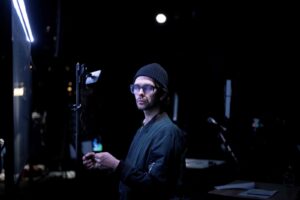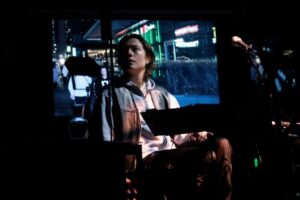Bluets is a dream of a show

Bluets is not a theatre show, it’s an unusual hybrid of stage and screen. It certainly won’t appeal to everyone, particularly those who love pure theatre. On the plus side, it’s not like far too many recent gimmicky stage productions where video is used to provide close-ups or scenes of what’s happening off-stage. Normally I would avoid that sort of thing, but this is something special.
It’s the making of a film, live, with the actors reciting words from Maggie Nelson’s book Bluets, while carrying out actions that are projected on a large screen. I admit this sounds more like something you might see at Tate Modern, and without the presence of Ben Whishaw, maybe it wouldn’t have made it to the stage of the Jerwood Downstairs theatre at the Royal Court. Having said that, director Katie Mitchell does have a long and distinguished record of creating what she calls ‘live cinema’. But, if it does sound strange, or even off-putting to you, I can only say I found Bluets both fascinating and deeply moving.

The language- its rhythms and metaphors- is poetic and moving. It’s also quite funny in a self-deprecating way. For example, she is excited to come across a book called Deepest Blue (I think) in a bookshop, only to find it’s about depression. She hastily puts it back, only to tell us she bought it six months later – pause- ‘online’.

Then there is the videoing. Each actor has a table next to them, a camera in front of them, and a monitor behind them. The film, shown on a big screen above them, illustrates what is being said. The actors sometimes stand in front of the monitors, as if they are green screens, and this, thanks to superb lighting by Anthony Doran, converts onto the large screen as them seeming to walk down a street, drive a car, or dry their hair in a changing room. Often, the actors’ heads or hands are viewed in close-up as they rest on a pillow, or touch each other, or handle blue objects. It is an extraordinary experience to watch them talk and move, sometimes in synch, and then see this, combined with some pre-recorded moments, become a movie before one’s eyes.